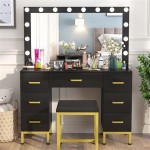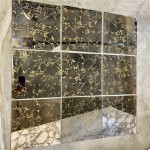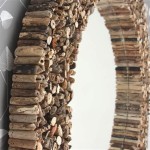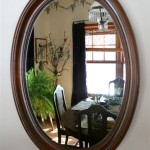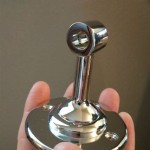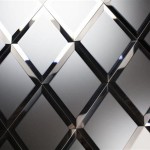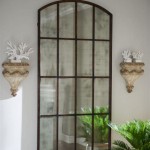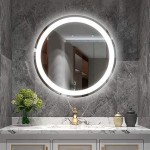How High Should a Bathroom Mirror Be Above a Vanity?
Determining the ideal height for a bathroom mirror above a vanity involves considering several factors, including user height, vanity height, and the overall bathroom design. A properly positioned mirror ensures functionality and contributes to a cohesive and aesthetically pleasing bathroom space. This article will explore the key elements to consider when making this important design decision.
Standard Measurements and Guidelines
While individual needs vary, industry standards and general guidelines provide a valuable starting point. A common recommendation is to position the bottom edge of the mirror approximately 5-10 inches above the vanity countertop. This range provides a comfortable viewing distance for most individuals while also protecting the mirror from splashes and toothpaste spills.
The top edge of the mirror should generally be at least a few inches taller than the tallest member of the household. This ensures adequate headroom and allows for a full view. In bathrooms with standard 8-foot ceilings, the top edge of the mirror can often be positioned around 68-72 inches from the floor. However, ceilings higher than 8 feet may necessitate adjustments to this measurement.
The Importance of User Height
Standard measurements provide a useful framework, but considering the specific heights of those using the bathroom is crucial for optimal mirror placement. For households with significant height differences, a compromise may be necessary. A slightly higher placement might favor taller individuals while still remaining accessible to shorter users.
In situations with drastically varying heights, such as children and adults sharing a bathroom, consider installing two mirrors at different heights. A smaller, lower mirror can cater to children's needs while a larger, higher mirror accommodates adults.
The Role of Vanity Height
The height of the vanity itself plays a significant role in determining mirror placement. Standard vanity heights typically range from 30-36 inches. Lower vanities require the mirror to be positioned lower as well, while higher vanities allow for higher mirror placement. Maintaining the 5-10 inch gap between the vanity top and the mirror's bottom edge remains important regardless of vanity height.
Impact of Lighting and Mirror Size
The size and shape of the mirror and the surrounding lighting significantly impact the perceived height and functionality. Larger mirrors provide a more expansive view and can create the illusion of a larger space. They may require adjustments to the standard height recommendations to ensure full visibility. Vertical mirrors are generally more suitable for viewing one's full reflection, while horizontal mirrors can visually widen a smaller bathroom.
Adequate lighting is essential for proper mirror usage. Wall sconces flanking the mirror should ideally be positioned approximately 60-66 inches from the floor, regardless of mirror height. Overhead lighting should be bright and evenly distributed to eliminate shadows.
Design and Aesthetic Considerations
Beyond functionality, the mirror's placement contributes to the overall aesthetic of the bathroom. The mirror should be proportionate to the vanity and the surrounding space. A small mirror above a large vanity can appear unbalanced, while an oversized mirror in a small bathroom can feel overwhelming. Consider the style of the mirror frame and how it complements the existing décor.
The mirror can also be used as a focal point within the bathroom design. A uniquely shaped or framed mirror can add visual interest and personality. However, it’s important to maintain the functional aspects of mirror placement even when prioritizing design elements.
Practical Tips for Installation
Before installing the mirror, it's advisable to use a template or masking tape to visualize the placement on the wall. This allows for adjustments and ensures the chosen height is satisfactory before making permanent fixtures. Consider using a level to ensure the mirror hangs straight. Secure mounting hardware appropriate for the mirror's weight and the wall material.
Accessibility Considerations
In designing for accessibility, adhering to the Americans with Disabilities Act (ADA) guidelines is essential. ADA compliance requires specific height considerations for mirrors in public restrooms and accessible residential bathrooms. Consulting the ADA Standards for Accessible Design is crucial for ensuring compliance in these settings.
Conclusion
Positioning a bathroom mirror correctly is a critical element in optimizing both functionality and aesthetics. While standard measurements offer a starting point, taking into account user height, vanity height, mirror size, and lighting are critical for creating a comfortable and visually appealing bathroom environment.

How High Should You Hang The Mirror In A Bathroom With Photos Design Morsels

Bathroom Mirror Size Calculator

How To Pick And Hang The Perfect Bathroom Mirror Roomhints

How High To Hang A Vanity Mirror Sparrow Stoll

Guide To Hanging Bathroom Vanity Lighting And Mirrors Liven Design

How To Pick And Hang The Perfect Bathroom Mirror Roomhints

How To Pick And Hang The Perfect Bathroom Mirror Roomhints

How High To Hang A Vanity Mirror Sparrow Stoll

How High To Place Your Bathroom Fixtures Inspired Style

How High To Place Your Bathroom Fixtures Inspired Style

